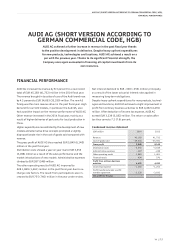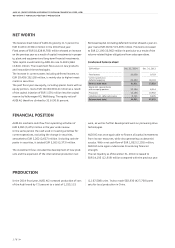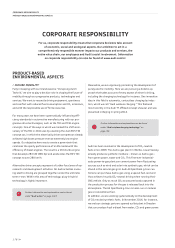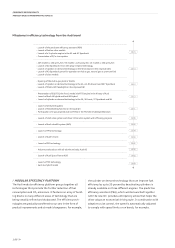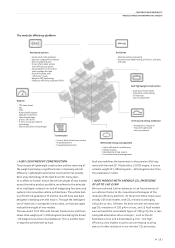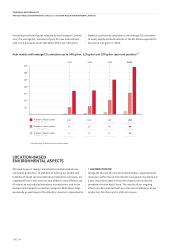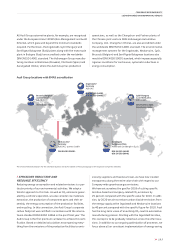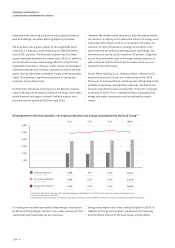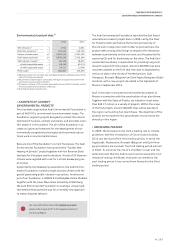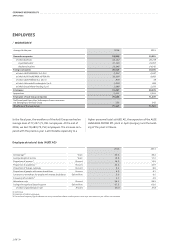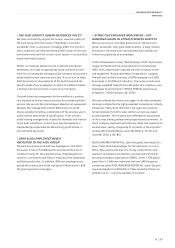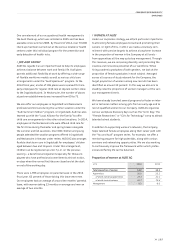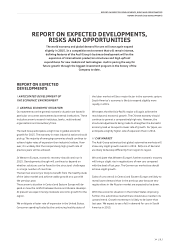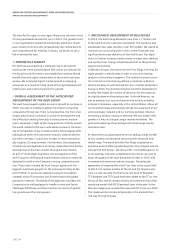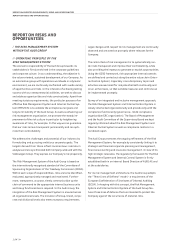Audi 2014 Annual Report Download - page 185
Download and view the complete annual report
Please find page 185 of the 2014 Audi annual report below. You can navigate through the pages in the report by either clicking on the pages listed below, or by using the keyword search tool below to find specific information within the annual report.
CORPORATE RESPONSIBILITY
LOCATION-BASED ENVIRONMENTAL ASPECTS
>>
185
Environmental structural data 1)
2014 2013
VOC emissions 2) t 1,914 2,041
Direct CO2 emissions 3) t 199,563 210,749
Volume of waste water m³ 2,628,236 2,431,220
Fresh water purchased m³ 3,878,539 3,702,249
Total volume of waste 4) t 82,560 78,815
of which recyclable waste t 68,349 65,274
of which disposable waste t 14,211 13,540
Metal waste t 345,847 332,294
1) Ingolstadt, Neckarsulm, Brussels, GyƉr, Sant’Agata Bolognese and Bologna (since 2013)
plants; 2014 figures provisional
2) VOC emissions (volatile organic compounds): This figure comprises emissions from the
paint shops, test rigs and other facilities.
3) This figure is made up of CO2 emissions generated by the use of fuel at the plant, and CO2
emissions produced by the operation of test rigs.
4) Including non-product-specific waste
/
EXAMPLES OF CURRENT
ENVIRONMENTAL PROJECTS
The charitable organization Audi Environmental Foundation is
part of AUDI AG’s commitment to environmental issues. The
foundation supports projects designed to protect the natural
livelihood of humans, animals and plants, and promotes scien-
tific research in this context. The aim of the foundation is to
create an optimum framework for the development of envi-
ronmentally acceptable technologies and to promote educa-
tional work on environmental issues.
Bees are one of the foundation’s current focal areas. The Audi
Environmental Foundation has launched the “Top-Bar Bee-
keeping in Schools” project together with the Bavarian State
Institute for Viticulture and Horticulture. A total of 26 Bavarian
schools were supplied with a set for a school beekeeping pro-
ject group.
Supported by two beekeeping associations, the Audi Environ-
mental Foundation maintains eight colonies of bees with the
goal of generating public interest in apiculture. Another pro-
ject of our foundation is HOBOS 4.0 (HOneyBee Online Studies).
Together with the Julius Maximilian University of Würzburg,
the Audi Environmental Foundation is creating a unique high-
tech beehive that paves the way for an entirely new approach
to researching bee behavior.
For more information about the beekeeping project,
please refer to page 94 ff. in the magazine section of
the Annual Report.
The Audi Environmental Foundation launched the Oak Forest
international research project back in 2008. Led by the Chair
for Forest Growth and Yield at the Technical University of
Munich and in conjunction with further project partners, the
project seeks among other things to research the interaction
between stand density on the one hand, and the potential for
capturing CO2 and for biodiversity on the other. The Audi Envi-
ronmental Foundation is responsible for providing long-term
research support for this project. Around 100,000 trees have
now been planted on the first trial site close to Ingolstadt as
well as on sites in the vicinity of the Neckarsulm, GyƉr
(Hungary), Brussels (Belgium) and Sant’Agata Bolognese (Italy)
locations, with a new project site added in the highlands of
Mexico in September 2014.
Audi is now also running various environmental projects in
Mexico in connection with the construction of our plant there.
Together with the State of Puebla, we intend to invest more
than EUR 17 million in a variety of projects. Within the scope
of the first project, around 100,000 trees will be planted in
the region surrounding San José Chiapa. The objectives of the
projects are to replenish the groundwater and promote bio-
diversity in the region.
/
EMISSIONS TRADING
In 2005, the European Union took a leading role in climate
protection with the introduction of CO2 emissions trading.
2013 saw the start of the third trading period, in which the
Ingolstadt, Neckarsulm, Brussels (Belgium) and GyƉr (Hun-
gary) locations are involved. The third trading period will end
in 2020. To minimize the risk of a shortfall in cover and the
potential costs that the Audi Group could consequently incur,
instead of selling certificates that were not needed in the
past trading period it has carried them forward to the third
trading period.


